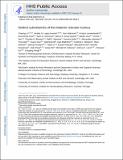Distinct subnetworks of the thalamic reticular nucleus
Author(s)
Li, Yinqing; Lopez Huerta, Violeta; Adiconis, Xian; Levandowski, Kirsten; Choi, Soonwook; Simmons, Sean K.; Arias-Garcia, Mario A.; Guo, Baolin; Yao, Annie; Blosser, Timothy R.; Wimmer, Ralf D; Aida, Tomomi; Atamian, Alexander; Naik, Tina; Sun, Xuyun; Bi, Dasheng; Malhotra, Diya; Hession, Cynthia C.; Shema Tirosh, Reut; Gomes, Marcos; Li, Taibo; Hwang, Eunjin; Krol, Alexandra; Kowalczyk, Monika; Peça, João; Pan, Gang; Halassa, Michael; Levin, Joshua Z.; Fu, Zhanyan; Feng, Guoping; ... Show more Show less
DownloadAccepted version (1.796Mb)
Publisher Policy
Publisher Policy
Article is made available in accordance with the publisher's policy and may be subject to US copyright law. Please refer to the publisher's site for terms of use.
Terms of use
Metadata
Show full item recordAbstract
The thalamic reticular nucleus (TRN), the major source of thalamic inhibition, regulates thalamocortical interactions that are critical for sensory processing, attention and cognition1–5. TRN dysfunction has been linked to sensory abnormality, attention deficit and sleep disturbance across multiple neurodevelopmental disorders6–9. However, little is known about the organizational principles that underlie its divergent functions. Here we performed an integrative study linking single-cell molecular and electrophysiological features of the mouse TRN to connectivity and systems-level function. We found that cellular heterogeneity in the TRN is characterized by a transcriptomic gradient of two negatively correlated gene-expression profiles, each containing hundreds of genes. Neurons in the extremes of this transcriptomic gradient express mutually exclusive markers, exhibit core or shell-like anatomical structure and have distinct electrophysiological properties. The two TRN subpopulations make differential connections with the functionally distinct first-order and higher-order thalamic nuclei to form molecularly defined TRN–thalamus subnetworks. Selective perturbation of the two subnetworks in vivo revealed their differential role in regulating sleep. In sum, our study provides a comprehensive atlas of TRN neurons at single-cell resolution and links molecularly defined subnetworks to the functional organization of thalamocortical circuits.
Date issued
2020-07Department
McGovern Institute for Brain Research at MIT; Massachusetts Institute of Technology. Department of Brain and Cognitive Sciences; Klarman Cell Observatory (Broad Institute)Journal
Nature
Publisher
Springer Science and Business Media LLC
Citation
Li, Yinqing et al. "Distinct subnetworks of the thalamic reticular nucleus." Nature 583, 7818 (July 2020): 819–824. © 2020 The Author(s)
Version: Author's final manuscript
ISSN
0028-0836
1476-4687